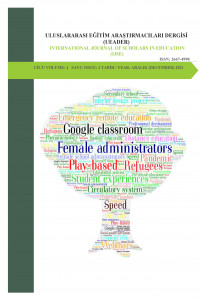Abstract
This article introduces a play-based activity that aims to assist pupils to primarily appreciate the concept of speed. An integrative STEM education approach was adopted in determining the objectives of the study. The activity particularly aimed to improve skills in using tools and materials strategically, collecting data, reasoning abstractly and quantitatively, and describing the logical connection between distance and time. An authentic learning environment was created. Two pupils with the assistance of their parents built, colored, and participated in a jumping frog contest. During the contest, they measured distances and time intervals, created a data table, and discussed and calculated the speeds of various frogs. In every action, the pupils were asked to focus on particular aspects of the activity setting. They initially focused on how to fold a paper frog, which was the first contextualizing action where they have seen the connection between scratch paper, folding, and a jumping frog. Next, they were asked to focus on race where they realized the connection between measuring distance, taking time, and creating a data table. In the last contextualizing action, in the process of determining the champion, they recognized the relationship between distance, time, and speed.
Supporting Institution
Bulunmamaktadır
Project Number
Bulunmamaktadır
Thanks
Bulunmamaktadır
References
- Hewitt, P. G., Suchocki, J., & Hewitt, L. A. (1999). Conceptual physical science (2nd Edition). New York, NY: Addison Wesley Longman.
- Saglam, Y. (2015). Contextualizing action for the abstraction of scientific knowledge. Eurasia Journal of Mathematics, Science & Technology Education, 11(6), 1621-1632. doi:10.12973/eurasia.2015.1426a
- Sanders, M. (2009). STEM, STEM education, STEM mania. The Technology Teacher, 68(4), 20-26.
- Rogoff, B. (1990). Apprenticeship in thinking: Cognitive development in social context. New York, NY: Oxford University Press.
- van Oers, B. (2001). Contextualisation for abstraction. Cognitive Science Quarterly, 1, 279-305.
- Vygotsky, L. S. (1978). Mind in society: The development of higher psychological processes. Cambridge, MA: Harvard University Press.
- Vygotsky, L. S. (1983). The history of higher mental functions. In Collected Works. V. 3. Moscow: Pedagogika (in Russian, written in 1931).
- Vygotsky, L. S., & Luria, A. R. (1993). Studies on the history of behavior: Ape, primitive and child. Hilsdale, N. J.: Erlbaum.
- Vygotsky, L. S. (2016). Play and its role in the mental development of the child. International Research in Early Childhood Education, 7(2), 3-25.
- Wertsch, J. V. (1991). Voices of the mind: A sociocultural approach to mediated action. Cambridge, Massachusetts: Harvard University Press.
Abstract
This article introduces a play-based activity that aims to assist pupils to primarily appreciate the concept of speed. An integrative STEM education approach was adopted in determining the objectives of the study. The activity particularly aimed to improve skills in using tools and materials strategically, collecting data, reasoning abstractly and quantitatively, and describing the logical connection between distance and time. An authentic learning environment was created. Two pupils with the assistance of their parents built, colored, and participated in a jumping frog contest. During the contest, they measured distances and time intervals, created a data table, and discussed and calculated the speeds of various frogs. In every action, the pupils were asked to focus on particular aspects of the activity setting. They initially focused on how to fold a paper frog, which was the first contextualizing action where they have seen the connection between scratch paper, folding, and a jumping frog. Next, they were asked to focus on race where they realized the connection between measuring distance, taking time, and creating a data table. In the last contextualizing action, in the process of determining the champion, they recognized the relationship between distance, time, and speed.
Keywords
Activity Integrative STEM education Play-based Speed integrative STEM education integrative STEM education integrative STEM education integrative STEM education
Project Number
Bulunmamaktadır
References
- Hewitt, P. G., Suchocki, J., & Hewitt, L. A. (1999). Conceptual physical science (2nd Edition). New York, NY: Addison Wesley Longman.
- Saglam, Y. (2015). Contextualizing action for the abstraction of scientific knowledge. Eurasia Journal of Mathematics, Science & Technology Education, 11(6), 1621-1632. doi:10.12973/eurasia.2015.1426a
- Sanders, M. (2009). STEM, STEM education, STEM mania. The Technology Teacher, 68(4), 20-26.
- Rogoff, B. (1990). Apprenticeship in thinking: Cognitive development in social context. New York, NY: Oxford University Press.
- van Oers, B. (2001). Contextualisation for abstraction. Cognitive Science Quarterly, 1, 279-305.
- Vygotsky, L. S. (1978). Mind in society: The development of higher psychological processes. Cambridge, MA: Harvard University Press.
- Vygotsky, L. S. (1983). The history of higher mental functions. In Collected Works. V. 3. Moscow: Pedagogika (in Russian, written in 1931).
- Vygotsky, L. S., & Luria, A. R. (1993). Studies on the history of behavior: Ape, primitive and child. Hilsdale, N. J.: Erlbaum.
- Vygotsky, L. S. (2016). Play and its role in the mental development of the child. International Research in Early Childhood Education, 7(2), 3-25.
- Wertsch, J. V. (1991). Voices of the mind: A sociocultural approach to mediated action. Cambridge, Massachusetts: Harvard University Press.
Details
| Primary Language | English |
|---|---|
| Subjects | Studies on Education |
| Journal Section | Articles |
| Authors | |
| Project Number | Bulunmamaktadır |
| Early Pub Date | December 31, 2021 |
| Publication Date | December 31, 2021 |
| Submission Date | June 29, 2021 |
| Acceptance Date | November 1, 2021 |
| Published in Issue | Year 2021 Volume: 4 Issue: 2 |
|
| |



